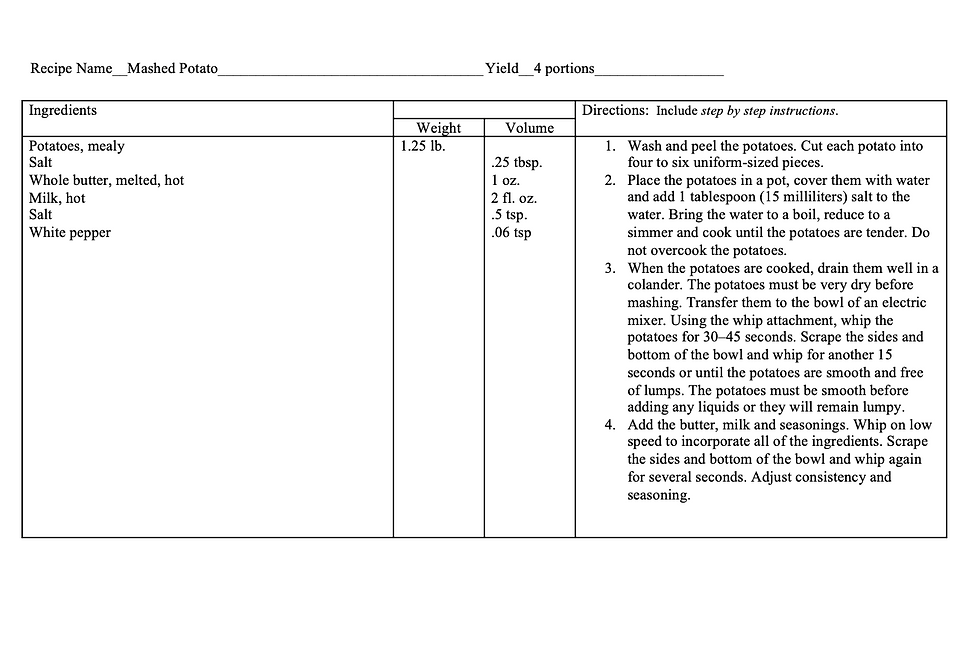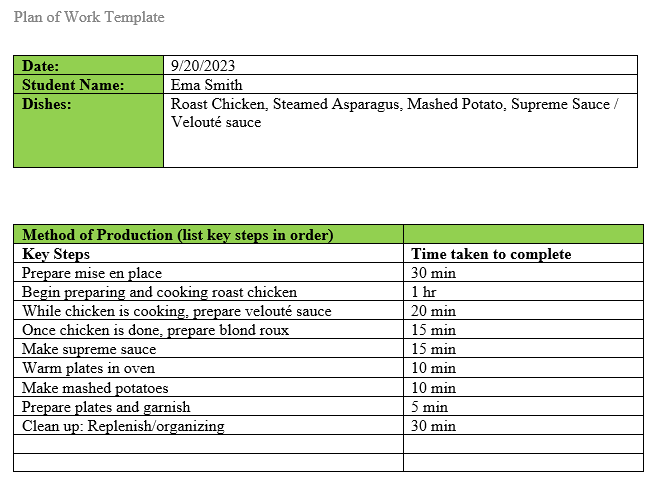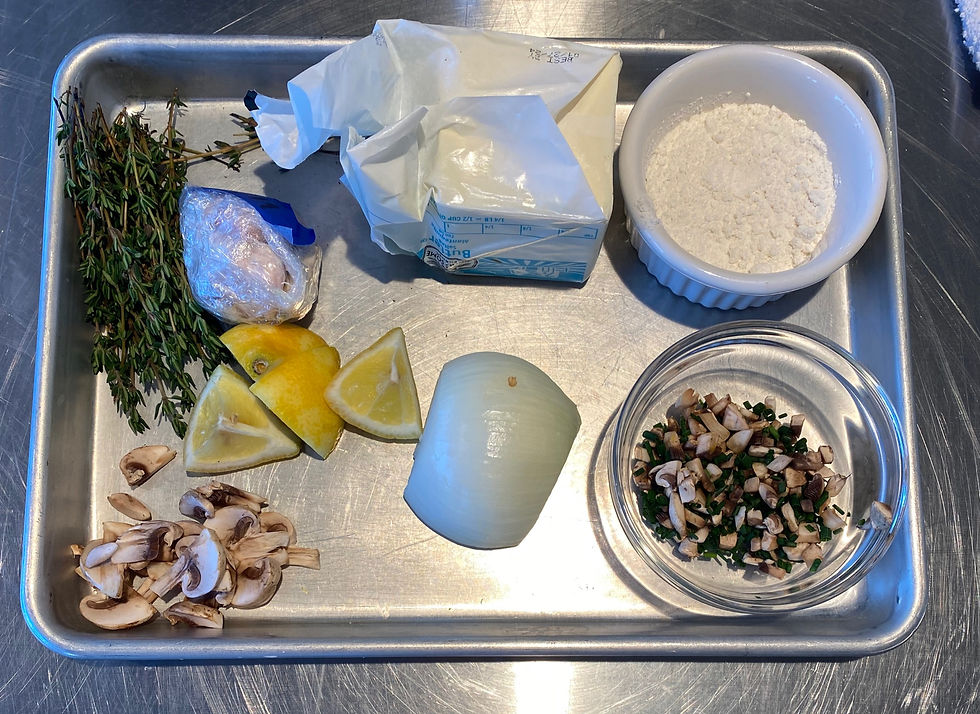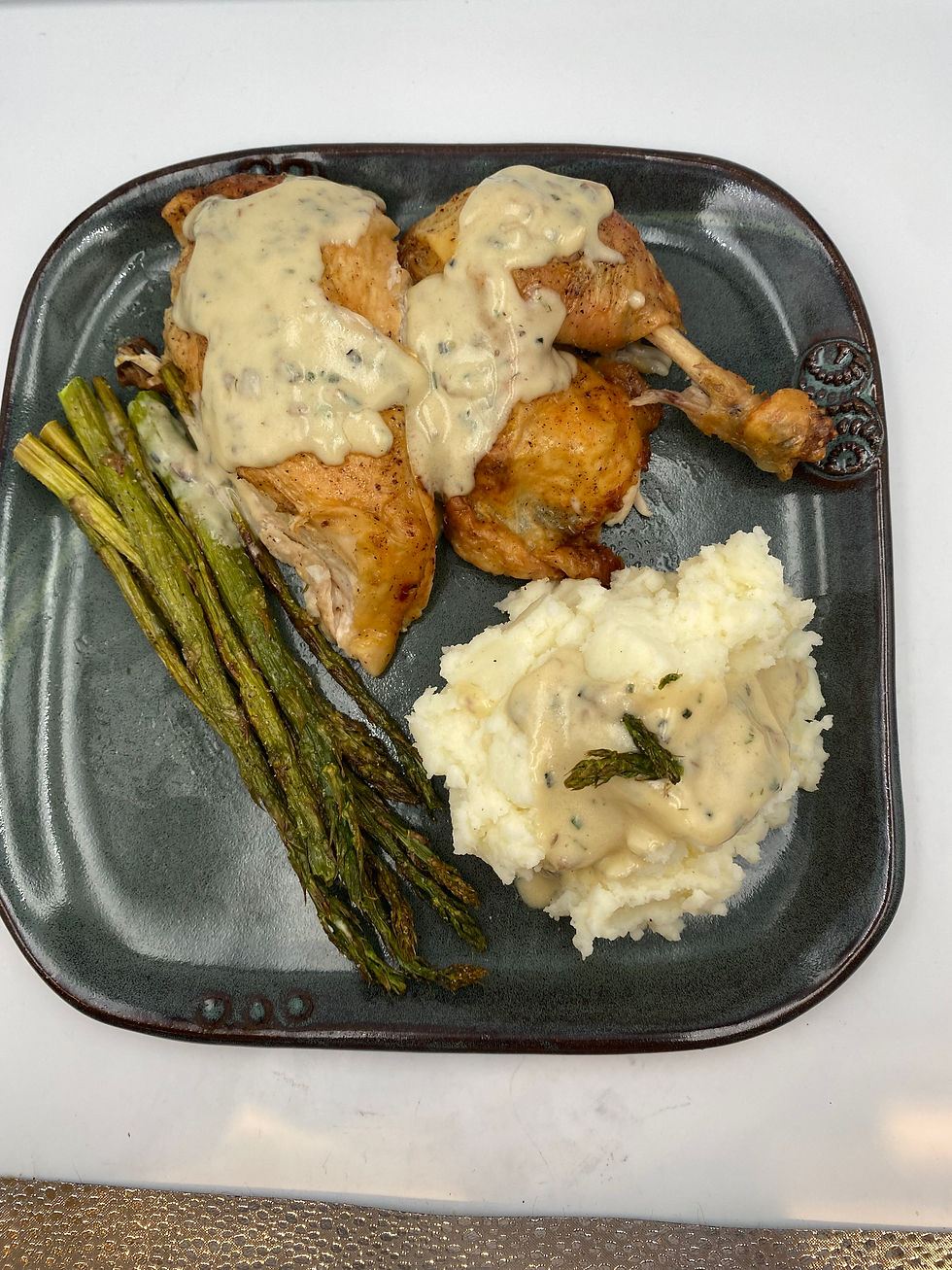Week 5: Roasting
- ejs0086
- Sep 20, 2023
- 11 min read
Updated: Sep 27, 2023
Research
Introductions
List the method of cookery and dishes to be covered in class
This week we progress towards a more complicated menu including roast chicken and mashed potatoes with supreme sauce. Roasting is a method of employing dry heat cooking that uses convection heat inside an oven to cook meats, poultry, and some vegetables. The air must be above 300 degrees and involves the addition of a fat or an oil added to the product. Roasting normally includes whole or larger cuts of meat. The end result is a browning of the outside of the food product which produces flavor. A variation of roasting includes spit roasting where the meat is continuously rotated over radiant heat (think pig roast!). Roasting can also include hot roasting whereby you cook the meat over a bed of vegetables in a covered pan or pot inside the oven. This week, we will be creating a traditional roast of only chicken (after removing the neck, giblets, and liver) and reserving juices to make a roux. There is much discussion on how long and what heat to roast a chicken. An article by Food52 suggests roasting at “450°F to 475°F—to get that skin crispy. After 30 minutes, lower to 300°F for another 15 to 20 minutes before taking it out” (Macdonald 2019). We will also create mashed potatoes, which use peeling, boiling, draining, and mashing methods. In addition, we will create a velouté sauce using a blond roux and a white stock.
List your learning objectives for the class
I hope to correctly truss the chicken in class this week so that it cooks evenly. There are a lot of steps for trussing a chicken, still it is important that I remember exactly how and where to tie the string. Truthfully, I have never prepared or cooked chicken in my life; I just watched other people do it using different cooking methods. Hence, I am excited to cook chicken for the first time this week using one of the many cooking methods, and I hope that it does not turn out like the dry turkey from Christmas Vacation (if you know what movie reference I’m talking about)! Acquiring a smooth, consistent texture for the sauce will take determination and timeliness, so I will try my best to achieve the desired results for the supreme sauce. I always thought that you can‘t mess up mashed potatoes, but that is not true; I aim to create smooth mashed potatoes that are free of lumps and are not too thick or too watery.
Discuss your prior knowledge of the content
Before doing my additional research, I knew that chicken must reach an internal temperature of 165°F to be fully cooked. Chicken is not like steak where you can choose how you like it cooked. We will be using convection to roast the chicken in class this week. However, prior to reading about this dry heat method, I thought convection was strictly used to make pastries (like cake and muffins) rise more so that they are fluffy.
Background Information
Research and discussion of method of cooking/ techniques
We will utilize a roasting technique for chicken this week, along with whipping mashed potatoes and simmering supreme sauce. Roasting methods vary depending on the meat, vegetables, and desired inclusivity. For this week’s menu, the chicken will be roasted alone without any other added vegetables. The mashed potatoes will be boiled, drained, and seasoned separately. The supreme sauce involves chicken velouté sauce plus mushroom stems, heavy cream, and seasonings. A classic velouté sauce is one of the five French “mother” sauces made with only three ingredients: butter, flour, and stock (Simply Recipes 2022); this involves a delicate simmering of ingredients.
Research and discussion of primary ingredient
The primary ingredient for roast chicken is, you guessed it, chicken! We will be using a whole chicken and will remove the neck, giblets, and liver. After roasting and basting at reduced temperatures, the outcome should be a moist meat with flavorful aromas and taste, especially when the pan gravy (supreme sauce) is drizzled on top. Mashed potatoes perfectly complement any roasted meat. This recipe includes delicious, whole butter and hot milk to create a creamy texture after whipping; it is seasoned with salt and pepper. I learned something interesting from this recipe, which is that no liquids should be added until potatoes are smooth and free of lumps. The velouté sauce will be topped with a supreme sauce that is derived from the chicken pan drippings, complemented with mushrooms, cream, salt, and pepper. An article explaining how to make this dish says, “Velouté sauce is a savory sauce made from a roux and white stock. It is one of the five "mother sauces" in French cuisine and is used as the base for other sauces (known as "small sauces"), such as allemande, supreme, and crème. The classic small sauces made from velouté are all named for their flavoring ingredients: white wine (fricassee), mushrooms (champignon), tomatoes (tomato), cayenne pepper, or chili powder (piquant) and tarragon (Estragon)” (Mon Panier 2023).
Dish/method variations - discuss the variations of the dish or the methods of cooking
Roasted chicken stands alone as champion, separately from grilling, boiling or frying. It is, by far, the best result for moist, flavorful meat, due to the slow process of roasting. Potatoes can be baked, roasted, or fried, but nothing pairs better with roasted meat than mashed potatoes! They can be paired with asparagus, green beans, broccoli - really any green vegetable. One thing I might change in the recipe would be to use whipping cream instead of milk, for a creamier texture.
Recipes



Plan of Work

Report & Reflect

Results
Describe the outcomes of the lab class
Lab class this week was a bit stressful, but the cooking process went very well. My lab partner was the Sous Chef for the day, and we were separated from our other two group mates, so I was very independent this time. I successfully trussed and prepared the chicken, whipped together creamy mashed potatoes, made a flavorful veloute (through lots of hard work - my arm is still sore five days later from rapidly stirring), and perfectly cooked the asparagus.
Describe how well the technique/cooking method worked
Roasting the chicken worked extremely well and allowed for a flavorful, moist roast chicken despite being slightly overcooked on accident. I cut the potatoes into small cubes so that boiling would be efficient, but it may have overcooked the potatoes just a little bit. I could easily tell when they were tender from their cloudy-clear appearance and by poking a fork through them to test the resistance. We used a potato ricer to whip the potatoes first, then used a spoon for an even smoother texture. Simmering the supreme sauce was extremely tricky because the design of the stove top made it difficult to find the desired temperature. If I barely turned on the stove, nothing happened; if I increased the temperature by just a hair more, suddenly it was scorching hot. Either my sauce was burning, or it was not even simmering in the slightest, so I was constantly readjusting the heat and taking my pan off the stove to cool down. Furthermore, whisking the sauce for approximately 30 minutes did not work well in the slightest. I had no help from my team during this process so I was physically drained from continuous exertion and stress.
Describe the sensory results of the dish
Taste
The roast chicken turned out exceptionally well. Despite almost being overcooked, the chicken exhibited a savory taste from the seasoned skin and moist, buttered meat. Before topping the mashed potatoes with the sauce, they were very bland and needed much more seasoning. The supreme sauce was too salty by itself, but the taste balanced out when it was added on top of the roast chicken and mashed potatoes. The sauce really tied the whole dish together. Combining the supreme sauce and roast chicken presented the ultimate umami taste. Additionally, the asparagus was too spicy as expected because we accidentally poured a large amount of pepper.
Flavor
This week's menu has, by far, been my favorite. The aromas of lemon and onion used to stuff the chicken enhanced the flavor of each bite. I decided to sauté chives and mushrooms in clarified butter and add it to our supreme sauce for a deep, well-rounded flavor. Together, the sauce and roast chicken presented a delicious, savory flavor with a rich, warm essence. The initially bland potatoes quickly became flavorful from the supreme sauce and especially the aromatic chives. Typically, I add garlic powder or use garlic salt instead of regular salt to season mashed potatoes and asparagus, but that was unavailable (due to an important reason that I will explain later on), and we did not have enough time to poach garlic. Hence, our asparagus was not as flavorful as I prefer it to be, but it exhibited the commonly desired flavor - per the Chef - after using oil, salt, and pepper and roasting them in the oven.
Texture
Roasting the chicken allowed for a crispy skin and tender inside. As I mentioned, the supreme sauce turned out a little too thick, but it softened once we added it to the chicken. Furthermore, the roast chicken topped with the supreme sauce was deliciously juicy. Our mashed potatoes were smooth yet thick, so pairing them with supreme sauce was crucial for the desired creamy texture. The oven-roasted asparagus was perfectly tender on the inside and crispy on the outside.
Appearance
Due to the lengthy process of making supreme sauce, I did not have time to prepare a visually appealing plate presentation. The roast chicken looked desirable before carving it, but I unknowingly chose the two worst pieces of chicken in terms of appearance; the skin was falling off, and meatless bones were visible on my plate. The mashed potatoes have no shape or form. The supreme sauce became runny when I used it to garnish the warm dishes, so it looked sloppy on top of the roast chicken and spilled off into the asparagus. Adding sauce and a couple of asparagus tips helped the appearance of the mashed potatoes. Perhaps the asparagus is the only visually appealing part of this dish, but in my defense, time was limited.

Our mise en place for the veloute.

The chicken I stuffed, trussed, and seasoned!

The asparagus, prior to cooking.

The finished product!
Evaluation of results
Explain and discuss the important outcomes using external references and citations
Acquiring the right consistency and texture of the supreme sauce was harder to do than I had expected. One second the sauce was too thin; the next it was too thick. The finished product turned out to be too salty and too thick due to a combination of mistakes. An article published by Eating Well explains what went wrong during my cooking process: "One mistake that can result in gravy that's too thick is adding too much thickener (or too little liquid). Another mistake is not taking into account the fact that gravy tends to thicken as it cools. When it's hot, gravy should be thick enough to coat the back of a spoon but not so thick that it sticks to the spoon like glue. If your gravy is hot and still too thick, add broth a little at a time to thin it out... If your gravy is finished and it's just too salty, add some broth or water to tamp it down. That will also thin it out, so you may have to thicken it back up again" (Meyer, 2019). Once I finished making the supreme sauce, I realized that the classmate who helped me gave me clarified butter instead of stock to thin it out. I then used chicken pan drippings (which are primarily just fat) in an attempt to fix it without realizing the saltiness of the drippings. Since fat and butter melt when heated, the two liquids did not thin the sauce but only made it saltier.
Discuss the techniques that did work well.
Roasting the chicken and asparagus worked very well; the process was relaxed, and we could focus on other parts of the meal while they were in the oven. With little effort, we prepared delicious roast chicken and oven-roasted asparagus that were crisp on the outside and tender on the inside.
Discuss the techniques that did not work well.
As I mentioned above and in recent blog posts, the rapid stirring technique was not and is still not working, especially for long periods of time. When I was making the supreme sauce alone, a classmate nearby kindly offered to help me when she noticed I didn't have someone to add ingredients while I stirred. Unfortunately, she added the chicken stock to the blond roux all at once rather than gradually adding it, instantly making a thick and lumpy veloute sauce. I began correcting the mistake before adding the next ingredients for the supreme sauce, but I suppose the classmate thought I was going on to the next step and added a large amount of heavy cream. All of these mishaps made whisking very difficult and strenuous. Perhaps a hands-free saucepan stirrer would be more efficient for whisking the supreme sauce. An article published by Best Arthritis Aids illustrates the benefits of using a hands-free sauce stirrer, which is as follows:
"Enables hands-free stirring: stirs automatically, allowing you to go hands-free and focus on other tasks while your sauce is cooking. This is particularly useful for anyone with arthritic hands or a weak grip.
Saves time and effort: you no longer have to stand by the stove constantly stirring. You can get on with other things while your sauce is cooking, saving you time and effort.
Safe to use on non-stick pots: safe to use on non-stick pots, so you can cook without worrying about damaging your cookware" (Hands Free, n.d.).
Discuss the particular improvements and changes that could be implemented to improve the outcomes.
I need to think before adding ingredients to my recipe when trying to fix it, or else I will continue to create more problems. Furthermore, I have learned to take suggestions from peers but not let them fix my problems; this led to unwanted outcomes regarding the supreme sauce.
Conclusions
Provide a concise and clear recap of the outcomes of the class.
Creating sauce is deceivingly complicated. I should've added stock or water to thin the supreme sauce rather than adding more butter, chicken pan drippings, and heavy creme. The mashed potatoes were overcooked and would have benefited from adding heavy cream and more butter and seasoning. Less pepper and more salt would be more suitable for the asparagus. The roasted chicken turned out exceptionally well.
Discuss the specific learning outcomes of the class and link them to the learning objectives that were previously identified.
I successfully remembered how to truss a chicken and executed it with little struggle. I aimed to acquire a smooth, consistent sauce and create mashed potatoes that are free of lumps and are not too thick, but these learning objectives were not met. I know now what I did wrong and how to correct my mistakes in the future, as I have detailed throughout this report.
Discuss additional skills and knowledge that were learned outside of the previously identified learning objectives.
Asparagus is my favorite vegetable, so I prepare it on a regular basis as a side dish for dinner. I originally learned how to prepare asparagus and mashed potatoes from my mom, but I never understood why the asparagus always had a burnt appearance, and the mashed potatoes were so thick. I learned in class that garlic powder burns easily and ruins the appearance of asparagus, so it is best to poach garlic and grind it up into a paste. Furthermore, if you use a mixer to whip mashed potatoes, they will become thick and chewy because starch molecules will begin to break down from being disturbed (Plana, 2023).
I didn't truly understand the difference between roux, veloute sauce, and supreme sauce until I learned it through personal experience in class. Hence, I decided to make a visual map to illustrate my newfound knowledge of distinguishing between roux and sauces.

Explain the potential circumstances that the newly-found skills and knowledge could be applied.
The menu this week is one that is a staple meal in almost every household and during many holidays. Now that I have learned how to make roast chicken, asparagus, and mashed potatoes properly, I will be preparing these dishes at home quite often. Additionally, I will share this information with my mom to help her fix these underlying mistakes that she has unknowingly been making all these years.
Detail areas that still require practice and improvement.
Sauces! I have struggled to achieve the right consistency of the sauce each time, whether it be tomato sauce, the cream sauce for the fettuccine carbonara, or the supreme sauce. My time management has improved but I need to leave room for unplanned errors; it seems as though there are always external factors affecting my time management, such as appliance troubles (poor stovetop design), time-consuming cooking demonstrations, and distant team members.
References
Best Arthritis Aids. (n.d.). Hands free sauce stirrer. Sauce Stirrer | Kitchen Aids for
Arthritis | Best Arthritis Aids. https://www.bestarthritisaids.co.uk/sauce-stirrer#:~:text=Saves%20time%20and%20effort%3A%20you,worrying%20about%20damaging%20your%20cookware.
Macdonald, K. (2019, September 8). The best way to roast a whole chicken,
according to 5 chefs. Best Roast Chicken Recipes. https://food52.com/blog/23678-how-long-to-roast-chicken-recipes-oven-absolute-best
Meyer, H. (2019, October 7). 6 mistakes that Ruin Gravy (and how to fix them).
EatingWell. https://www.eatingwell.com/article/2054294/mistakes-that-ruin-gravy-and-how-to-fix-them/
Mon Panier Latin. (n.d.). Veloute Sauce : How You Make It. Mon Panier Latin.
https://monpanierlatin.co.uk/blogs/mpl-blog/veloute-sauce
Vargas, S. (2023, May 5). Become a kitchen wizard with classic velouté sauce!.
Classic Velouté Sauce Recipes. https://www.simplyrecipes.com/classic-veloute-sauce-recipe-5225173#:~:text=A%20classic%20velouté%20sauce%20is,butter%2C%20flour%2C%20and%20stock.



Comments